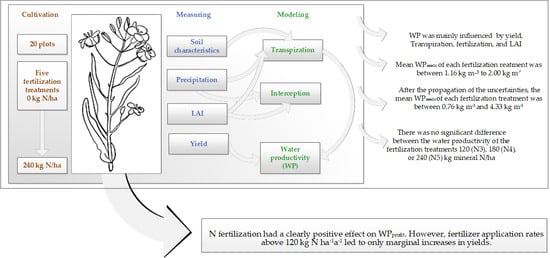Case Study of Effects of Mineral N Fertilization Amounts on Water Productivity in Rainfed Winter Rapeseed Cultivation on a Sandy Soil in Brandenburg (Germany) over Three Years
Abstract
:1. Introduction
2. Materials and Methods
2.1. Study Site
2.2. Measurements
2.2.1. Weather
2.2.2. Soil Parameters
2.2.3. Leaf Area Index and Yield
2.3. Calculations
2.3.1. Hydrological Variables
2.3.2. Water Productivity
2.3.3. Calculation of Optimum Nitrogen Fertilization Rates
2.3.4. Statistical Analyses
2.3.5. Calculation of Uncertainty
- (1)
- Natural randomness (XN)
- (2)
- Input data (XI)
- (3)
- Model parameters and model structure (XM)
3. Results
3.1. Influence of N Fertilization Levels
3.1.1. Influence of N Fertilization Levels on Leaf Area Index and Seed Yield
3.1.2. Influence of N Fertilization Levels on Hydrological Variables
3.2. Variance of the Three Years and of the N Fertilization Levels
| Factors | Factor Levels | massoutput (Mg ha−1 a−1) | LAI (–) | I (mm) | T (mm) | WPseeds (kg m−3) |
|---|---|---|---|---|---|---|
| Year | 2013 | 3.75 A [3.55; 3.94] | 4.83 B [4.23; 5.42] | 180.5 B [174.2; 186.8] | 243.2 A [238.6; 247.7] | 1.55 A [1.47; 1.64] |
| 2014 | 4.81 B [4.56; 5.06] | 3.84 A [3.36; 4.31] | 159.4 A [151.4; 167.3] | 250.4 B [246.9; 254.0] | 1.94 B [1.82; 2.06] | |
| 2015 | 3.61 A [3.42; 3.79] | 5.89 C [5.35; 6.44] | 191.7 C [187.1; 196.2] | 243.4 AB [232.9; 253.9] | 1.52 A [1.39; 1.64] | |
| Fertilization treatment (kg mineral N ha−1 a−1) | 0 | 2.85A [2.59; 3.12] | 2.62A [1.78; 3.47] | 134.9 A [125.6; 144.3] | 260.5 B [252.3; 268.7] | 1.16 A [1.02; 1.30] |
| 60 | 3.75B [0.35; 0.40] | 4.22 AB [3.38; 5.07] | 175.0 B [165.6; 184.3] | 249.7 AB [241.5; 257.9] | 1.52 B [1.39; 1.66] | |
| 120 | 0.43 BC [3.49; 4.02] | 5.01 BC [4.47; 5.56] | 184.5 BC [178.5; 190.6] | 243.7 A [238.8; 248.6] | 1.73 BC [1.59; 1.88] | |
| 180 | 4.60C [4.35; 4.86] | 5.96 C [5.45; 6.46] | 193.9 C [188.4; 199.4] | 238.3 A [233.5; 243.2] | 1.92 C [1.79; 2.06] | |
| 240 | 4.81 C [4.54; 5.08] | 6.42 C [5.59; 7.29] | 197.6 C [188.2; 206.9] | 236.2 A [228.0; 244.4] | 2.00 C [1.87; 2.14] |
3.3. Optimum Nitrogen Fertilization Rates
3.4. Uncertainty
4. Discussion
4.1. Influence of N Fertilization Levels on LAI, Yield, Hydrological Variables, and WP
4.2. Optimum Nitrogen Fertilization Rates
4.3. Uncertainty and Method Applied
- the types of water used (i.e., technical water, evapotranspiration water originating from precipitation and waste water);
- the inclusion of transpiration vs. evapotranspiration as water input;
- the inclusion of different outputs;
- the focus on direct water use in agricultural production vs. water demand for production inputs often referred to as indirect water use, e.g., building materials, machinery, energy, fertilizer; and
- the different goals and scales of the studies.
4.4. Other Agronomic Practices
5. Conclusions
Author Contributions
Funding
Institutional Review Board Statement
Informed Consent Statement
Data Availability Statement
Acknowledgments
Conflicts of Interest
Appendix A
| Date | 15 May 2013 | 29 May 2013 | 12 June 2013 | 3 July 2013 | 17 July 2013 | ||
| Number of plots | 16 | 16 | 16 | 16 | 16 | ||
| Date | 12 April 2014 | 23 April 2014 | 21 May 2014 | 18 June 2014 | 27 June 2014 | 2 July 2014 | 16 July 2014 |
| Number of plots | 6 | 6 | 20 | 20 | 6 | 20 | 6 |
| Date | 22 April 2015 | 6 May 2015 | 27 May 2015 | 10 June 2015 | |||
| Number of plots | 20 | 19 | 18 | 20 |
| Affected Value | N0 (0) | N1 (60) | N2 (120) | N3 (180) | N4 (240) | Mean | Method/Reason for Neglecting | |
|---|---|---|---|---|---|---|---|---|
| Natural randomness | ||||||||
| XN,P | P | 6% | 6% | 6% | 6% | 6% | 6% | CV (three years) |
| Input data | ||||||||
| XI,P | P | <2% | <2% | <2% | <2% | <2% | <2% | Assumed measurement error |
| XN,P + XI,P | P | 8% | 8% | 8% | 8% | 8% | 8% | |
| XI,Y | YieldSeeds | 24% | 13% | 21% | 16% | 18% | 18% | CV |
| Model parameters, Model structure | ||||||||
| XM,T | T | 45% | 45% | 45% | 45% | 45% | 45% | SDT a |
| XM,I | I | 109% | 109% | 109% | 109% | 109% | 109% | SDI b |
References
- Jagermeyr, J.; Gerten, D.; Schaphoff, S.; Heinke, J.; Lucht, W.; Rockstrom, J. Integrated crop water management might sustainably halve the global food gap. Environ. Res. Lett. 2016, 11. [Google Scholar] [CrossRef]
- DWD Klimareport Brandenburg Climate Report Brandenburg; Deutscher Wetterdienst Offenbach/Main. 2019, p. 40. Available online: https://www.dwd.de/DE/leistungen/klimareport_bb/klimareport_bb.html (accessed on 23 April 2021).
- Drastig, K.; Prochnow, A.; Baumecker, M.; Berg, W.; Brunsch, R. Agricultural water management in Brandenburg. Wassermanagement in der Landwirtschaft in Brandenburg. Die Erde. 2011, 142, 119–140. Available online: http://www.die-erde.org/index.php/die-erde/article/download/45/40 (accessed on 23 April 2021).
- Steidl, J.; Schuler, J.; Schubert, U.; Dietrich, O.; Zander, P. Expansion of an Existing Water Management Model for the Analysis of Opportunities and Impacts of Agricultural Irrigation under Climate Change Conditions. Water 2015, 7, 6351–6377. [Google Scholar] [CrossRef]
- Descheemaeker, K.; Bunting, S.W.; Bindraban, P.; Muthuri, C.; Molden, D.; Beveridge, M.; van Brakel, M.; Herrero, M.; Clement, F.; Boelee, E.; et al. Increasing water productivity in agriculture. In Managing Water and Agroecosystems for Food Security; Boelee, E., Ed.; CABI: Wallingford, UK, 2013; pp. 104–123. Available online: https://www.iwmi.cgiar.org/Publications/CABI_Publications/CA_CABI_Series/Managing_Water_and_Agroecosystems/chapter_8-increasing_water_productivity_in_agriculture.pdf (accessed on 23 April 2021).
- Bouman, B.A.M. A conceptual framework for the improvement of crop water productivity at different spatial scales. Agric. Syst. 2007, 93, 43–60. [Google Scholar] [CrossRef]
- Perry, C.J. The IWMI water resources paradigm–definitions and implications. Agric. Water Manag. 1999, 40, 45–50. [Google Scholar] [CrossRef]
- Davies, W.J.; Bennett, M.J. Achieving more crop per drop. Nat. Plants 2015, 1, 15118. [Google Scholar] [CrossRef]
- Boulay, A.; Drastig, K.; Amanullah; Chapagain, A.; Charlon, V.; Civit, B.; Hess, T.; Hoekstra, A.; Ibidhi, R.; Lathuillière, M.; et al. Building consensus on water use assessment of livestock production systems and supply chains: Outcome and recommendations from the FAO LEAP Partnership. Ecol. Indic. 2021, 124, 107391. [Google Scholar] [CrossRef]
- FAO. Water Use in Livestock Production Systems and Supply Chains–Guidelines for Assessment (Version 1). Livestock Environmental Assessment and Performance (LEAP) Partnership. Rome. 2019. Available online: http://www.fao.org/partnerships/leap/resources/guidelines/en/ (accessed on 23 April 2021).
- Molden, D. Accounting for Water Use and Productivity SWIM Paper 1; International Irrigation Management Institute: Colombo, Sri Lanka, 1997; Available online: http://www.iwmi.cgiar.org/Publications/SWIM_Papers/PDFs/SWIM01.PDF (accessed on 23 April 2021).
- Prochnow, A.; Drastig, K.; Klauss, H.; Berg, W. Water use indicators at farm scale: Methodology and case study. Food Energy Secur. 2012, 1, 29–46. [Google Scholar] [CrossRef]
- Krauss, M.; Kraatz, S.; Drastig, K.; Prochnow, A. The influence of dairy management strategies on water productivity of milk production. Agric. Water Manag. 2015, 147, 175–186. [Google Scholar] [CrossRef]
- Krauß, M.; Keßler, J.; Prochnow, A.; Kraatz, S.; Drastig, K. Water productivity of poultry production: The influence of different broiler fattening systems. Food Energy Secur. 2015, 4, 76–85. [Google Scholar] [CrossRef]
- Drastig, K.; Palhares, J.C.P.; Karbach, K.; Prochnow, A. Farm water productivity in broiler production: Case studies in Brazil. J. Clean. Prod. 2016, 135, 9–19. [Google Scholar] [CrossRef] [Green Version]
- Van Opstal, J.; Droogers, P.; Kaune, A.; Steduto, P.; Perry, C. Guidance on Realizing Real Water Savings with Crop Water Productivity Interventions; Wageningen, FAO and FutureWater: Wageningen, The Netherlands, 2021. [Google Scholar] [CrossRef]
- Branca, G.; Lipper, L.; McCarthy, N.; Zolejole, M.C. Food security, climate change, and sustainable land management: A review. Agron. Sustain. Dev. 2013, 33, 635–650. [Google Scholar] [CrossRef] [Green Version]
- Debnath, S.; Mishra, A.; Mailapalli, D.R.; Raghuwanshi, N.S. Quantifying yield gap for rice cropping systems in Lower Gangetic Plains. Paddy Water Environ. 2018, 16, 601–615. [Google Scholar] [CrossRef]
- Zegada-Lizarazu, W.; Monti, A. Energy crops in rotation: A review. Biomass Bioenergy 2011, 35, 12–25. [Google Scholar] [CrossRef]
- Pena-Asín, J.P.; Costar, A.; Alvarez, A. Effect of weeding management on the performance of local maize populations. Span. J. Agric. Res. 2013, 11, 1078–1084. [Google Scholar] [CrossRef] [Green Version]
- Lv, S.H.; Dong, Y.J.; Jiang, Y.; Padilla, H.; Li, J.; Uphoff, N. An opportunity for regenerative rice production: Combining plastic film cover and plant biomass mulch with no-till soil management to build soil carbon, curb nitrogen pollution, and maintain high-stable yield. Agronomy 2019, 9, 600. [Google Scholar] [CrossRef] [Green Version]
- LELF Datensammlung für Die Betriebswirtschaftliche Bewertung Landwirtschaftlicher Produktionsverfahren im Land Brandenburg Ackerbau/Grünland/Tierproduktion Ausgabe 2016. Available online: https://lelf.brandenburg.de/sixcms/media.php/9/Datensammlung%202016_web.pdf (accessed on 23 April 2021).
- Henke, J.; Breustedt, H.; Sieling, K.; Kage, H. Impact of uncertainty on the optimum nitrogen fertilization rate and agronomic, ecological and economic factors in an oilseed rape based crop rotation. J. Agric. Sci. 2007, 145, 455–468. [Google Scholar] [CrossRef]
- Drastig, K.; Quiñones, T.S.; Zare, M.; Dammer, K.-H.; Prochnow, A. Rainfall interception by winter rapeseed in Brandenburg (Germany) under various nitrogen fertilization treatments. Agric. Meteorol. 2019, 268. [Google Scholar] [CrossRef]
- Patil, B.; Lakkineni, K.; Bhargava, S. Ontogenic Changes in Growth and Assimilate Distribution as Influenced by N Supply in Rapeseed-mustard. J. Agron. Crop. Sci. 1997, 178, 15–21. [Google Scholar] [CrossRef]
- Gu, X.-B.; Li, Y.-N.; Du, Y.-D. Effects of ridge-furrow film mulching and nitrogen fertilization on growth, seed yield and water productivity of winter oilseed rape (Brassica napus L.) in Northwestern China. Agric. Water Manag. 2018, 200, 60–70. [Google Scholar] [CrossRef]
- Ruser, R.; Fuß, R.; Andres, M.; Hegewald, H.; Kesenheimer, K.; Köbke, S.; Räbiger, T.; Quiñones, T.S.; Augustin, J.; Christen, O. Nitrous oxide emissions from winter oilseed rape cultivation. Agric. Ecosyst. Environ. 2017, 249, 57–69. [Google Scholar] [CrossRef]
- WRB IUSS Working Group. World Reference Base for Soil Resources 2014, Update 2015. International Soil Classification System for Naming Soils and Creating Legends for Soil Maps; World Soil Resources Reports No. 106. FAO: Rome, Italy, 2015. Available online: http://www.fao.org/3/i3794en/I3794en.pdf (accessed on 23 April 2021).
- Wessolek, G.; Kaupenjohann, M.; Renger, M. Bodenphysikalische Kennwerte und Berechnungsverfahren für die Praxis. Bodenökologie und Bodengenese, 2009; Heft 40. Available online: https://www.boden.tu-berlin.de/fileadmin/fg77/_pdf/Rote_Liste/Rote_Reihe_Heft_40.pdf (accessed on 23 April 2021).
- Drastig, K.; Prochnow, A.; Kraatz, S.; Libra, J.; Krauß, M.; Döring, K.; Müller, D.; Hunstock, U. Modeling the water demand on farms. Adv. Geosci. 2012, 32. [Google Scholar] [CrossRef] [Green Version]
- Allen, R.; Pereira, L.; Raes, D.; Smith, M. Crop Evapotranspiration-Guidelines for Computing Crop Water Requirements-FAO Irrigation and Drainage Paper 56; FAO-Food and Agriculture Organization of the United Nations: Rome, Italy, 1998; p. 297. Available online: http://www.fao.org/3/X0490E/x0490e00.htm (accessed on 23 April 2021).
- von Hoyningen-Huene, J. Die Interzeption des Niederschlages in landwirtschaftlichen Pflanzenbeständen. DVWK Schriften. 1983, 57, 1–53. Available online: https://wiki.bluemodel.org/images/9/9e/DVWK_57_I.pdf (accessed on 23 April 2021).
- Braden, H. Ein Energiehaushalts- und Verdunstungsmodell für Wasser und Stoffhaushaltsuntersuchungen landwirtschaftlich genutzter Einzugsgebiete. Mitt. Dtsch. Bodenkdl. Ges. 1985, 42, 294–299. [Google Scholar]
- Kutschera, L.; Lichtenegger, E.; Sobotik, M. Wurzelatlas der Kulturpflanzen Gemäßigter Gebiete mit Arten des Feldgemüsebaues; DLG-Verlag: Frankfurt am Main, Germany, 2009. [Google Scholar]
- Döring, K.; Kraatz, S.; Prochnow, A.; Drastig, K. Indirect water demand of dairy farm buildings. Agric. Eng. Int. CIGR J. 2013, 15, 16–22. Available online: http://www.cigrjournal.org/index.php/Ejounral/article/view/2726 (accessed on 23 April 2021).
- Michelson, D.B. Systematic correction of precipitation gauge observations using analyzed meteorological variables. J. Hydrol. 2004, 290, 161–177. [Google Scholar] [CrossRef]
- Drastig, K.; Flemming, I.; Gusovius, H.J.; Herppich, W.B. Study of Water Productivity of Industrial Hemp under Hot and Dry Conditions in Brandenburg (Germany) in the Year 2018. Water 2020, 12, 2982. [Google Scholar] [CrossRef]
- Riar, A.; Gill, G.; McDonald, G. Different Post-Sowing Nitrogen Management Approaches Required to Improve Nitrogen and Water Use Efficiency of Canola and Mustard. Front. Plant Sci. 2020, 11, 1111. [Google Scholar] [CrossRef]
- German Federal Statistical Office. DESTATIS Database. 2017. Available online: www.destatis.de (accessed on 22 July 2020).
- Wei, C.; Huang, J.; Mansaray, R.L.; Li, Z.; Liu, W.; Han, J. Estimation and mapping of winter oilseed rape LAI from high spatial resolution satellite data based on a hybrid method. Remote. Sens. 2017, 9, 488. [Google Scholar] [CrossRef] [Green Version]
- Behrens, T.; Diepenbrock, W. Using digital image analysis to describe canopies of winter oilseed rape (Brassica napus L.) during vegetative developmental stages. J. Agron Crop Sc. 2006, 192, 295–302. [Google Scholar] [CrossRef]
- Grosse, F.; Leon, J.; Diepenbrock, W. Yield formation and yield structure of winter oilseed rape (Brassica napus L.). I. Genotypic variability. J. Agron. Crop. Sci. 1992, 169, 70–93. [Google Scholar] [CrossRef]
- Robertson, M.J.; Kirkegaard, J.A. Water-use efficiency of dryland canola in an equi-seasonal rainfall environment. Aust. J. Agric. Res. 2006, 56, 1373–1386. [Google Scholar] [CrossRef]
- LfL. Raps: Empfehlungen zum Anbau in Brandenburg; Landesanstalt für Landwirtschaft (LfL): Potsdam, Germany, 2001.
- Descheemaeker, K.; Amede, T.; Haileslassie, A. Improving water productivity in mixed crop–livestock farming systems of sub-Saharan Africa. Agric. Water Manag. 2010, 97, 579–586. [Google Scholar] [CrossRef]
- Kuotsu, K.; Das, A.; Lal, R.; Munda, G.; Ghosh, P.; Ngachan, S. Land forming and tillage effects on soil properties and productivity of rainfed groundnut (Arachis hypogaea L.)–rapeseed (Brassica campestris L.) cropping system in northeastern India. Soil Tillage Res. 2014, 142, 15–24. [Google Scholar] [CrossRef]
- Ševčíková, H.; Lhotáková, Z.; Hamet, J.; Lipavská, H. Mixotrophic in vitro cultivations: The way to go astray in plant physiology. Physiol. Plant. 2019, 167, 365–377. [Google Scholar] [CrossRef]
- Dai, L.; Li, J.; Harmens, H.; Zheng, X.; Zhang, C. Melatonin enhances drought resistance by regulating leaf stomatal behaviour, root growth and catalase activity in two contrasting rapeseed (Brassica napus L.) genotypes. Plant Physiol. Biochem. 2020, 149, 86–95. [Google Scholar] [CrossRef] [PubMed]
- Zhang, K.; Xing, Y.; Wang, G.; Shemi, R.; Duan, M.; Wang, L.; Xie, X. Ridge-furrow with film mulching practice ameliorates soil microbial metabolic activity and carbon utilization in rhizosphere soil of rapeseed (Brassica napus L.). J. Soils Sediments 2019, 19, 2764–2776. [Google Scholar] [CrossRef]
- Gu, X.-B.; Li, Y.-N.; Du, Y.-D. Biodegradable film mulching improves soil temperature, moisture and seed yield of winter oilseed rape (Brassica napus L.). Soil Tillage Res. 2017, 171, 42–50. [Google Scholar] [CrossRef]
- Feng, J.; Hussain, H.A.; Hussain, S.; Shi, C.; Cholidah, L.; Men, S.; Ke, J.; Wang, L. Optimum water and fertilizer management for better growth and resource use efficiency of rapeseed in rainy and drought seasons. Sustainability 2020, 12, 703. [Google Scholar] [CrossRef] [Green Version]
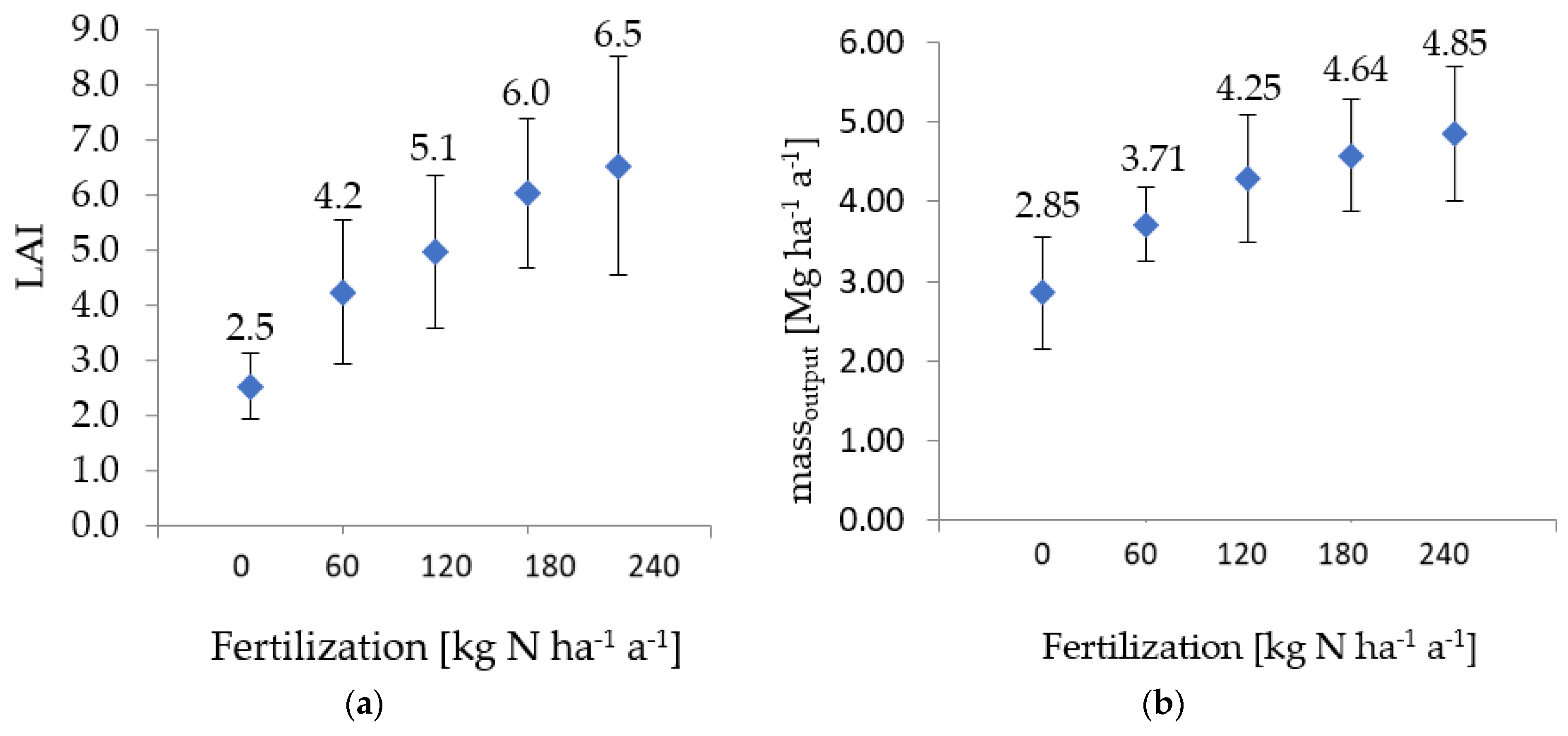
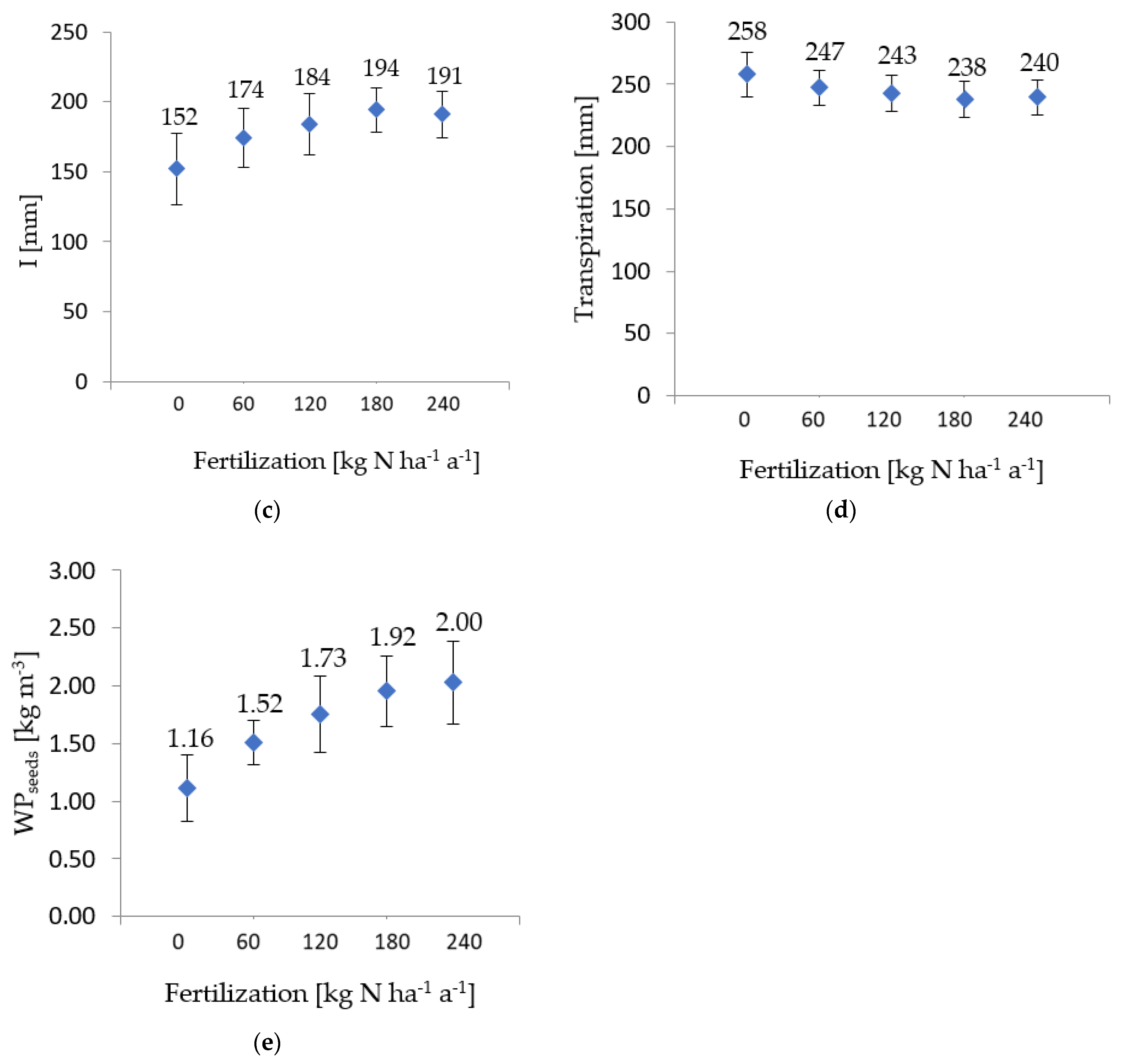
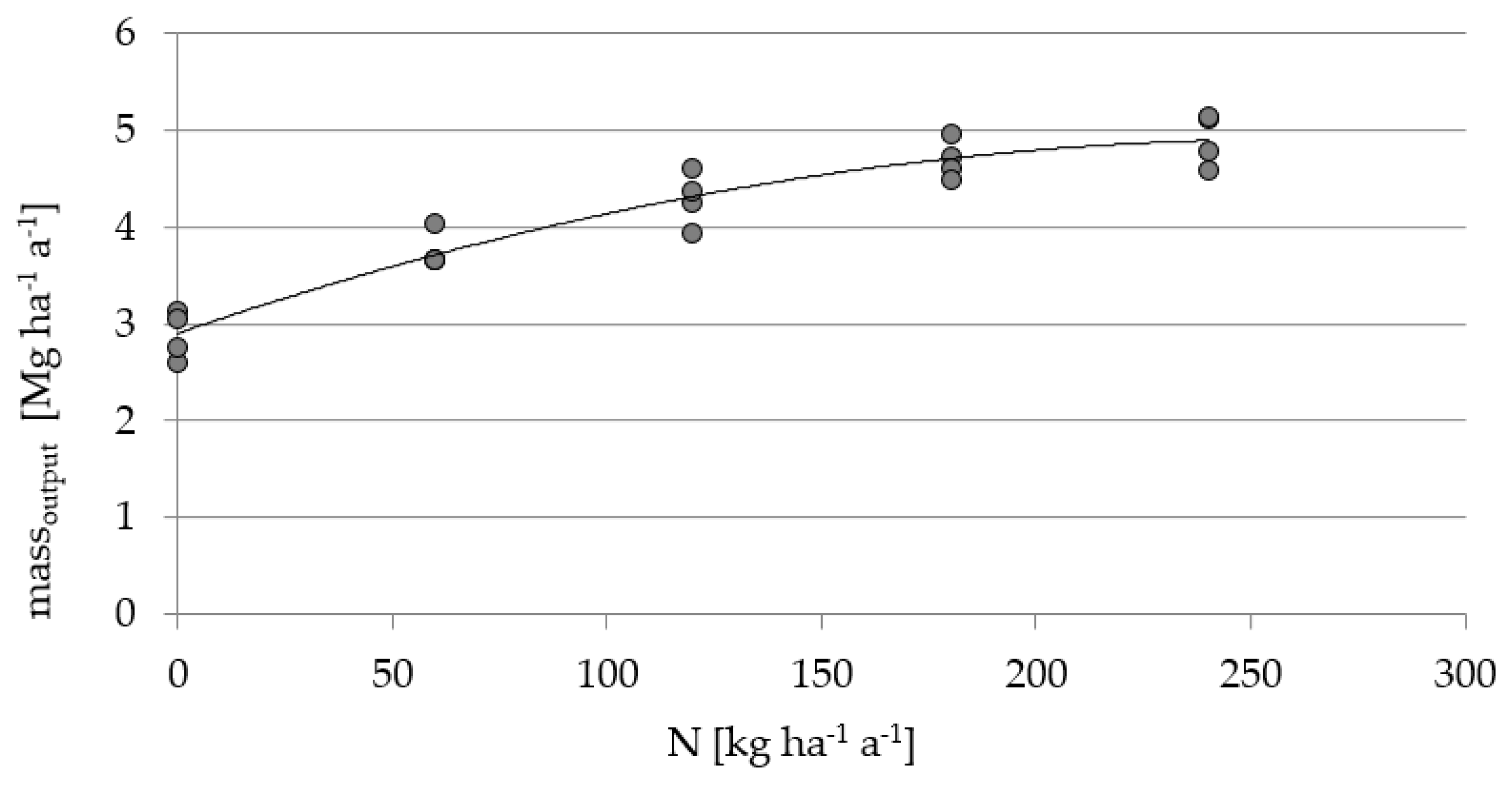
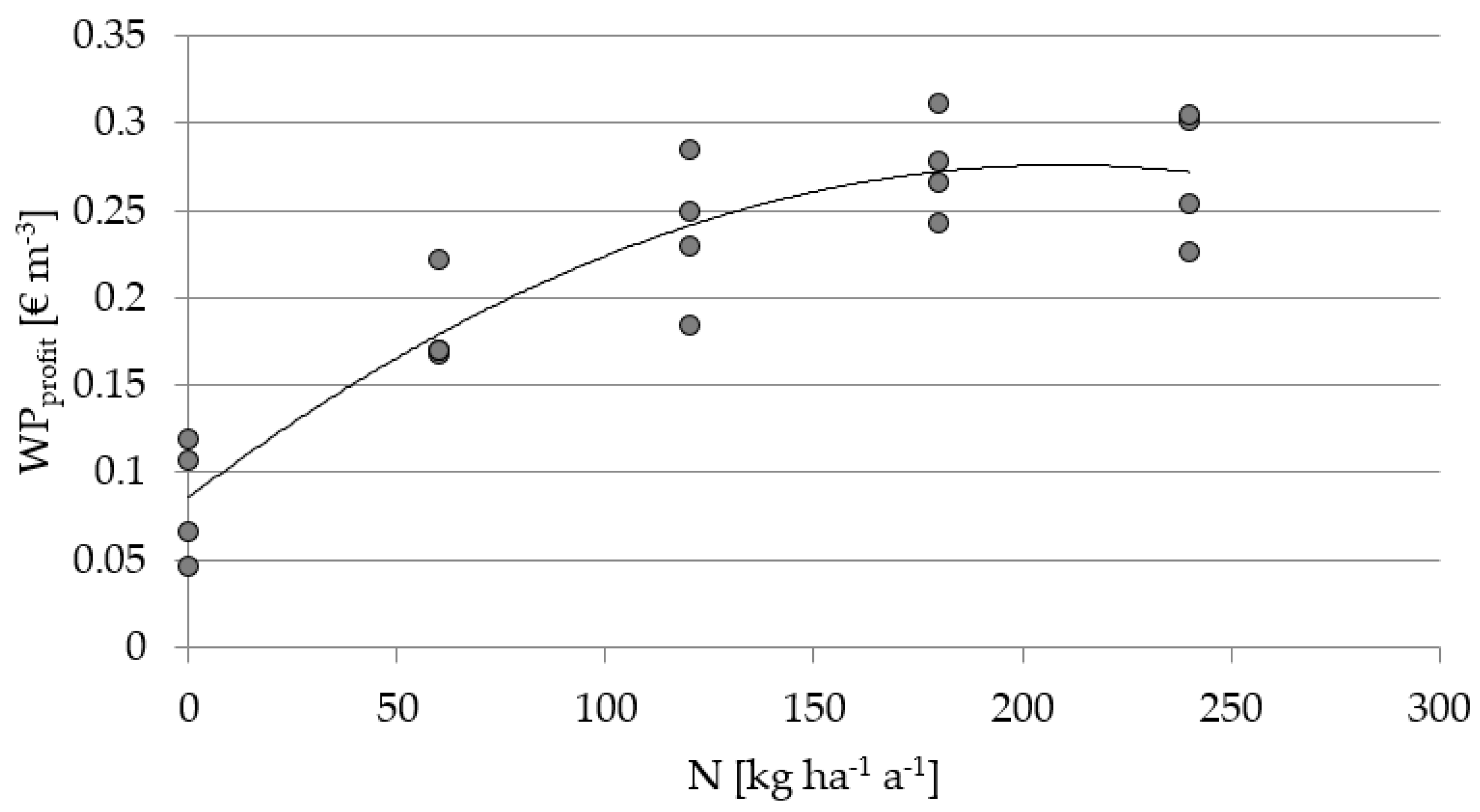
| (a) | Year | Precipitation (mm a−1) | Air Temperature (°C) | Wind Speed (m s−1) |
| 1985–2015 mean (± SD) | 509 (±130) | 8.7 (±3.2) | 3.2 (±0.3) | |
| 2012 | 501 | 9.6 | 3.6 | |
| 2013 | 615 | 9.4 | 3.2 | |
| 2014 | 482 | 10.9 | 3.1 | |
| 2015 | 570 | 10.6 | 3.5 | |
| (b) | Harvest Date of Previous Crop | Harvest Date of Rapeseed | Duration Vegetation + Fallow Period (d) | Precipitation in Vegetation + Fallow Period(mm) |
| 30 July 2012 | 1 August 2013 | 367 | 550 | |
| 16 July 2013 | 16 July 2014 | 365 | 562 | |
| 15 July 2014 | 28 July 2015 | 378 | 503 |
| Year | 2012–2013 | 2013–2014 | 2014–2015 | Fallow | ||||||
|---|---|---|---|---|---|---|---|---|---|---|
| Phase | Initial | Mid-season | Late season | Initial | Mid-season | Late season | Initial | Mid-season | Late season | |
| Start day a | 1 | 221 | 261 | 1 | 221 | 261 | 1 | 221 | 261 | 1 |
| End day | 220 | 260 | 289 | 220 | 260 | 289 | 220 | 260 | 289 | 42–51 |
| p (−) b | 0.6 | 0.6 | 0.6 | 0.6 | 0.6 | 0.6 | 0.6 | 0.6 | 0.6 | 0.55 |
| Zr (m) c | 0.3 | 1.5 | 0.3 | 1.5 | 0.3 | 1.5 | 0.3 | |||
| Height (m) | 1.27 | 1.48 | 1.49 | 0.3 | ||||||
| Kcb (−) b | 0.15 | 0.95 | 1.1 | 0.15 | 0.95 | 1.1 | 0.15 | 0.95 | 1.1 | 0.15 |
| LAI (m2 m−2) | 0.2 | 2.9–6.8 | 0.2 | 1.6–6.7 | 0.2 | 2.1–10.3 | 0.2 | |||
| Periods | 10 September 2012–1 August 2013 | 5 September 2013–16 July 2014 | 3 September 2014–28 July 2015 | 31 July–10 September 2012 16 July–5 September 2013 15 July–3 September 2014 | ||||||
| Treatment | N0 (0) | N1 (60) | N2 (120) | N3 (180) | N4 (240) | |||||
|---|---|---|---|---|---|---|---|---|---|---|
| Min | Max | Min | Max | Min | Max | Min | Max | Min | Max | |
| P (mm) | 496 | 580 | 496 | 580 | 496 | 580 | 496 | 580 | 496 | 580 |
| I (mm) | 0 | 318 | 0 | 364 | 0 | 384 | 0 | 406 | 0 | 399 |
| I (% of PMax) | 0 | 55% | 0 | 63% | 0 | 66% | 0 | 70% | 0 | 69% |
| T (mm) | 142 | 374 | 136 | 359 | 134 | 352 | 131 | 345 | 132 | 347 |
| Massoutput (kg m−2) | 0.29 | 0.36 | 0.37 | 0.42 | 0.42 | 0.50 | 0.46 | 0.53 | 0.48 | 0.57 |
| WPseeds | 0.76 | 2.50 | 1.04 | 3.07 | 1.21 | 3.75 | 1.34 | 4.08 | 1.40 | 4.33 |
Publisher’s Note: MDPI stays neutral with regard to jurisdictional claims in published maps and institutional affiliations. |
© 2021 by the authors. Licensee MDPI, Basel, Switzerland. This article is an open access article distributed under the terms and conditions of the Creative Commons Attribution (CC BY) license (https://creativecommons.org/licenses/by/4.0/).
Share and Cite
Drastig, K.; Kreidenweis, U.; Meyer-Aurich, A.; Ammon, C.; Prochnow, A. Case Study of Effects of Mineral N Fertilization Amounts on Water Productivity in Rainfed Winter Rapeseed Cultivation on a Sandy Soil in Brandenburg (Germany) over Three Years. Water 2021, 13, 1958. https://doi.org/10.3390/w13141958
Drastig K, Kreidenweis U, Meyer-Aurich A, Ammon C, Prochnow A. Case Study of Effects of Mineral N Fertilization Amounts on Water Productivity in Rainfed Winter Rapeseed Cultivation on a Sandy Soil in Brandenburg (Germany) over Three Years. Water. 2021; 13(14):1958. https://doi.org/10.3390/w13141958
Chicago/Turabian StyleDrastig, Katrin, Ulrich Kreidenweis, Andreas Meyer-Aurich, Christian Ammon, and Annette Prochnow. 2021. "Case Study of Effects of Mineral N Fertilization Amounts on Water Productivity in Rainfed Winter Rapeseed Cultivation on a Sandy Soil in Brandenburg (Germany) over Three Years" Water 13, no. 14: 1958. https://doi.org/10.3390/w13141958
APA StyleDrastig, K., Kreidenweis, U., Meyer-Aurich, A., Ammon, C., & Prochnow, A. (2021). Case Study of Effects of Mineral N Fertilization Amounts on Water Productivity in Rainfed Winter Rapeseed Cultivation on a Sandy Soil in Brandenburg (Germany) over Three Years. Water, 13(14), 1958. https://doi.org/10.3390/w13141958







